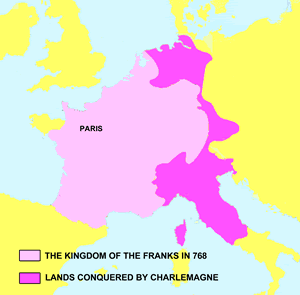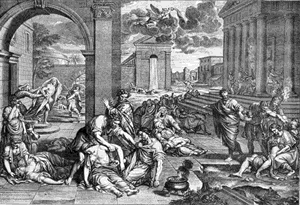
"To have another language is to possess a second soul."
-CHARLEMAGNE-
Medieval Europe: Dark Ages
In 476CE, warriors attacked the city of Rome and ended more than 800 years of glory for the "Eternal City." Historians mark the fall of Rome as the end of ancient history. The next one thousand years were called the Middle Ages. The Latin term for Middle Ages is "medieval."
The beginning of the Middle Ages is often called the "Dark Ages" because the great civilizations of Greece and Rome had fallen. Life in Western Europe during the Middle Ages was very hard. Very few people could read or write and nobody expected conditions to improve. The only hope for most people during the Middle Ages was their strong belief in Christianity, and the hope that life in heaven would be better than life on earth.
The Dark Ages were anything but dark in other parts of the world. The Muslims in the Middle East and North Africa studied and improved on the works of the ancient Greeks while civilization flourished in sub-Saharan Africa, China, India, and the Americas.
Europe began to experience great change by about 1450. Within one hundred years, Columbus had sailed to America, literacy spread, scientists made great discoveries, and artists created work that still inspires us today. Historians call the next period of European history the "Renaissance," or the "rebirth." The Renaissance is the beginning of modern history.
Charlemagne and the Franks
In 486, a warrior named Clovis defeated the Romans and established a kingdom centered in Paris. Clovis was a Frank, one of the many Germanic tribes that lived in Western Europe in the fifth century. Clovis worshipped pagan gods, in fact, his people believed Clovis to be the descendent of Wotan, the most powerful of the Frankish gods. In 496, Clovis and his soldiers fought another Germanic tribe. As the battle turned against Clovis, the Frankish king vowed to devote his life to Christianity if the Franks won the battle. After their unlikely victory, Clovis and 3000 of his soldiers were baptized by a Catholic bishop. Clovis and his soldiers established the power of the Franks and Christianity throughout their realm.
Islamic warriors crossed the Pyrenees Mountains in 732 and attempted to conquer the Franks. A Frankish general named Charles Martel defeated the Muslim army. This victory is considered the beginning of the reqonquista. The reconquista was the Christian reconquest of Europe after the invasion of the Moors.
Charlemagne, a name that means Charles the Great, was Charles Martel's grandson and the greatest of the Frankish kings. In an era when most men were little more than five feet tall, Charlemagne stood six feet, four inches. Charlemagne expanded the kingdom of the Franks into Spain and Central Europe. Although Charlemagne never learned to read or write, he wanted to recapture the glory of the Roman Empire. The Frankish king set up schools throughout his empire and provided funds that allowed monks to copy the works of Greek and Roman authors.
Charlemagne's goal was to unite all of the Germanic tribes into a single Christian kingdom. In 799, Charlemagne's armies rescued Pope Leo III from an attack. On Christmas Day, 800, the pope repaid the king for his assistance. As Charlemagne rose from prayer, Leo placed a crown on Charlemagne's head and proclaimed him "Augustus," emperor of the "Holy Roman Empire." The coronation united Christendom under Charlemagne's rule, but it also troubled the newly crowned emperor. Charlemagne was not prepared for his coronation and may not have wanted to be crowned by the Pope. If the Pope had the power to crown Charlemagne king, the Pope might also have the right to remove the crown. When Charlemagne named his son as his successor, he presided over the ceremony himself and did not invite the Pope. Many years later, as Napoleon was about to be crowned Emperor of France in 1804, he took the crown from Pope Pius VII and set it on his head Charlemagne's empire crumbled soon after his death, and the promise of returning the glory of Rome to Western Europe soon faded. The term Holy Roman Empire would be used to describe different Frankish and German lands for another ten centuries, but the empire never attained Charlemagne's promise of uniting Christendom into one kingdom. In 1806, Napoleon prepared to oust Francis II from his title as Holy Roman Emperor, so Francis renounced his title and decreed himself emperor of Austria. The Holy Roman Empire then ceased to exist after having been a part of Europe for more than a millennium.himself.
Feudalism
Feudalism was the system of loyalties and protections during the Middle Ages. As the Roman Empire crumbled, emperors granted land to nobles in exchange for their loyalty. These lands eventually developed into manors. A manor is the land owned by a noble and everything on it. A typical manor consisted of a castle, a small village, and farmland.
During the Middle Ages, peasants could no longer count on the Roman army to protect them. German, Viking and Magyar tribes overran homes and farms throughout Europe. The peasants turned to the landowners, often called lords, to protect them. Some peasants remained free, but many became serfs. A serf was bound to the land. He could not leave without buying his freedom, an unlikely occurrence in the Middle Ages. Life for a serf was not much better than the life of a slave. The only difference was that a serf could not be sold to another manor.
Serfs would often have to work three or four days a week for the lord as rent. They would spend the rest of their week growing crops to feed their families. Other serfs worked as sharecroppers. A sharecropper would be required to turn over most of what he grew in order to be able to live on the land.
The Black Death
A Great Plague killed nearly a third of the people of Europe during in the fourteenth century. A plague is a widespread illness. The plague was also known as "the Black Death" because of the black spots that formed on the skin of diseased people. The devastation of the plague brought great changes to Europe.
The sickness apparently began in Central Asia. In 1347, Italian merchant ships returned from the Black Sea, one of the links along the trade route between Europe and China. The ships were dirty and infested with rats. Fleas living on the blood of infected rats transferred the disease to the seamen. Many of the sailors were already dying of the plague as the infected ships returned to port, and within days of an infected ship's arrival, the disease spread from the port cities to the surrounding countryside. The plague reached Spain, France, England and Russia within three years. Although it is impossible to calculate exactly how many people died from the plague, evidence suggests that it claimed the lives of as many as 25 million Europeans.
The first sign of the plague was often an ache in the limbs. The lymph nodes would then swell. The lymph nodes are glands found in the neck, armpits, and groin. The swelling continued for three or four days until the lymph nodes burst. The illness is often called the Bubonic Plague. Buboes is a Greek word that refers to swollen glands.
The swiftness of the disease, the enormous pain and the grotesque appearance of its victims served to make the plague especially terrifying. Death from the plague was horrible, but swift. The Italian writer Boccaccio said victims often "ate lunch with their friends, and ate dinner with their ancestors in paradise."
Europeans were susceptible to disease because many people lived in crowded surroundings in an era when personal hygiene was not considered important. The Europeans often ate stale or diseased meat because refrigeration had not yet been invented. Fourteenth century medicine in Europe was primitive and unable to remedy an illness that modern technology might have cured. Bad medical advice also advanced the plague. People were advised to not bathe because open skin pores might let in the disease. The devastation of the plague led to advances in medicine. Cities began to build hospitals and enforce standards for sanitation.
Some Europeans believed the plague was a sign from God. Groups known as flagellants tried to atone for the sins of the world by inflicting punishments upon themselves. The flagellants also had a tendency to persecute Jews and even clergymen who spoke out against them. Eccentric and unusual people were often charged with witchcraft and sorcery. Pope Clement VI condemned the flagellants, but they continued to reappear in times of plague.
The Great Plague transformed European society. Entire villages were sickened, forcing the few remaining survivors to move to cities to find work. Labor shortages caused by the death toll led to increased wages. Feudal lands were often converted to grazing because grazing required less labor than farming. The need for a public response to the health crisis led to a weakening of feudalism and the development of more modern government in many places.
The Great Plague continued to affect cities from time to time for hundreds of years. It still exists and is common among rodents. We have a cure for the disease, but occasionally people in isolated places still die from Bubonic Plague.
DARK AGES CHARACTERS & SETTINGS
















